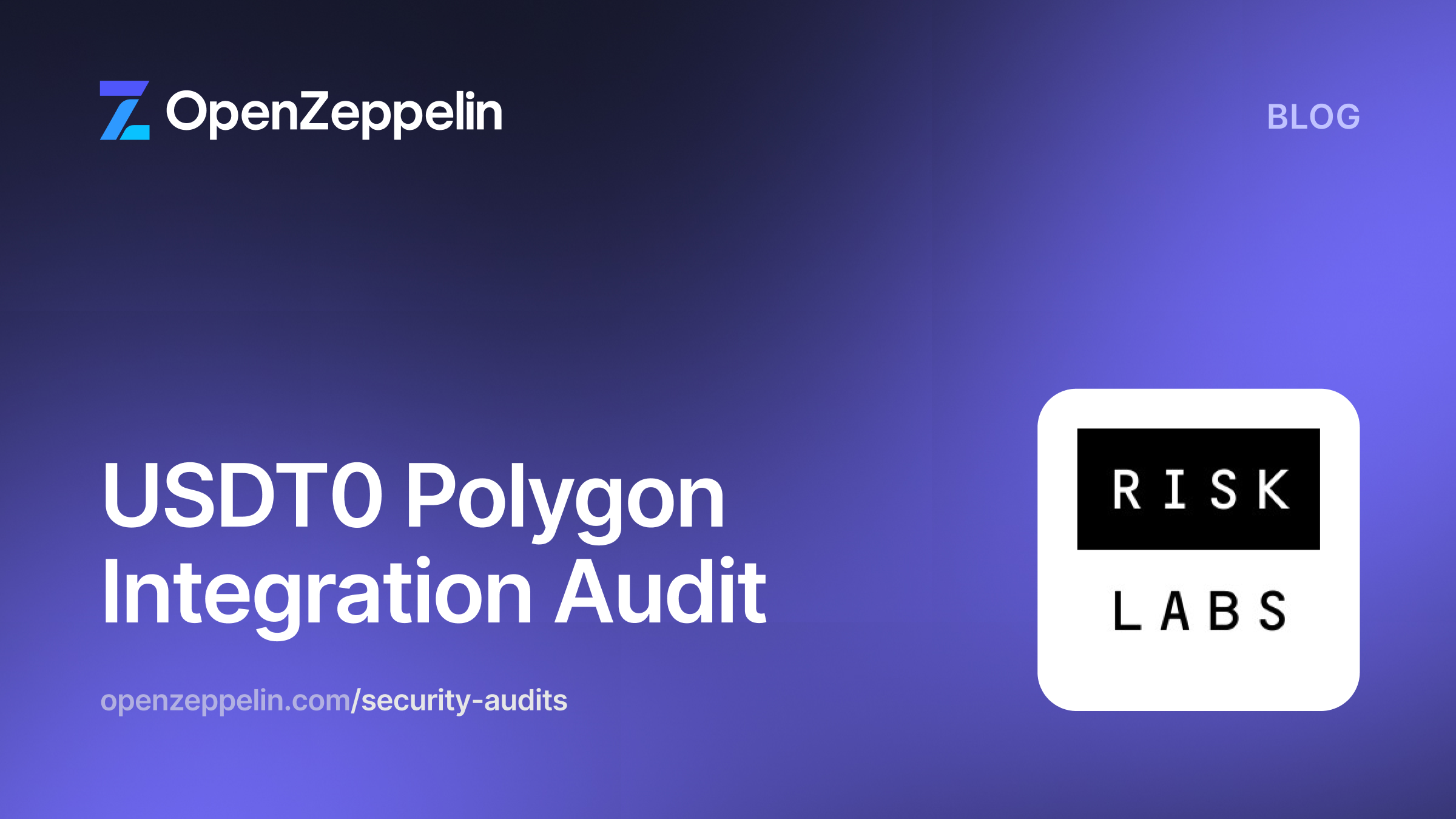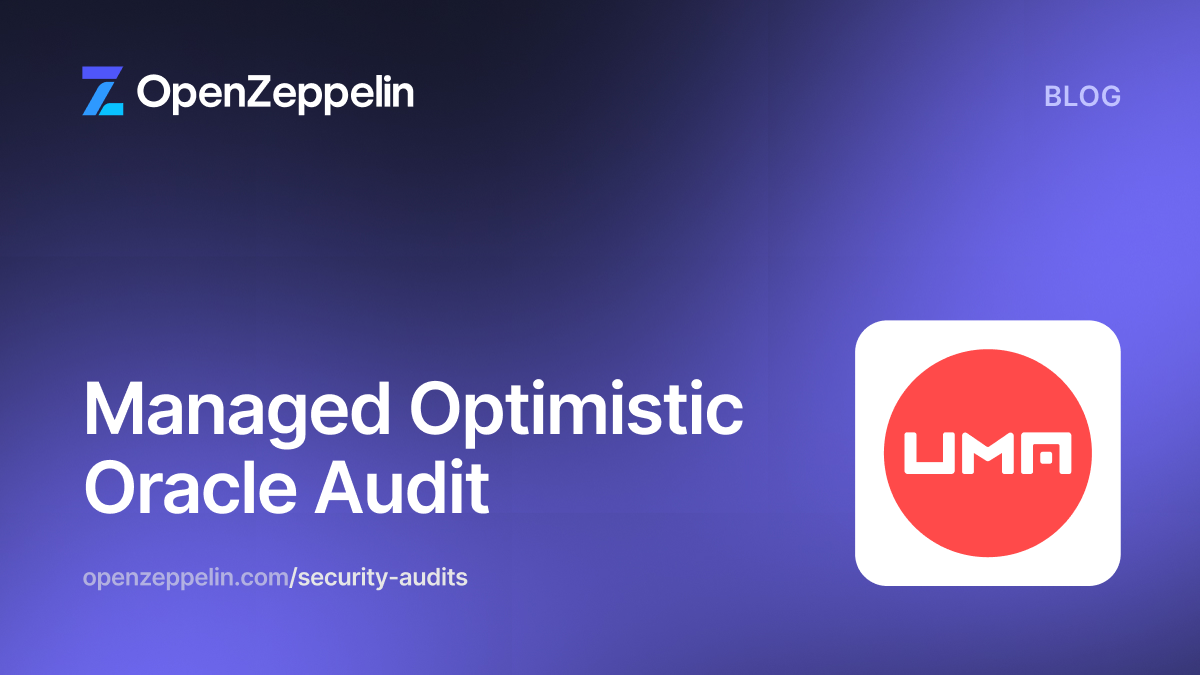Table of Contents
Summary
- Type
- Rollup
- Timeline
- From 2022-11-21
- To 2022-11-25
- Languages
- Solidity
- Total Issues
- 16 (15 resolved)
- Critical Severity Issues
- 1 (1 resolved)
- High Severity Issues
- 0 (0 resolved)
- Medium Severity Issues
- 2 (2 resolved)
- Low Severity Issues
- 4 (4 resolved)
- Notes & Additional Information
- 9 (8 resolved)
Scope
We performed a diff-audit of the matter-labs/zksync-2-dev repository at the 534dc37c7b86753803a31b836f78896d18372e7e commit against the post-audit version of the same repository at the 759fbd2cc9be96b266fbed0d5aa6f229c726af0f commit.
In scope were the following contracts:
contracts/ethereum/contracts
├── zksync
│ ├── Storage.sol
│ ├── DiamondInit.sol
│ ├── DiamondProxy.sol
│ ├── Config.sol
│ ├── facets
│ │ ├── Executor.sol
│ │ ├── Mailbox.sol
│ │ ├── DiamondCut.sol
│ │ ├── Getters.sol
│ │ ├── Governance.sol
│ │ └── Base.sol
│ ├── libraries
│ │ ├── Diamond.sol
│ │ ├── PriorityQueue.sol
│ │ ├── SafeCast.sol (new)
│ │ ├── UncheckedMath.sol (new)
│ │ └── Merkle.sol
│ └── interfaces
│ ├── IMailbox.sol
│ ├── IExecutor.sol
│ ├── IGetters.sol
│ ├── IDiamondCut.sol
│ ├── IGovernance.sol
│ └── IZkSync.sol
└── common
├── AllowList.sol (new)
├── AllowListed.sol (new)
└── interfaces
└── IAllowList.sol (new)
System Overview
zkSync is a layer 2 scaling solution for Ethereum based on zero-knowledge rollup technology. The protocol aims to provide low transaction fees and high throughput while maintaining full EVM compatibility.
An overview of the layer 1 system architecture has been provided in a previous audit report: zkSync Layer1 Audit.
Privileged Roles and Security Assumptions
In addition to the privileged roles described in the last audit report, the system contains the following additions and changes:
An additional allowlist enables granular access management to the Mailbox facet and the L1 ⇔ L2 bridges built upon it.
The security council changed from a set of individual addresses to a single address that is assumed to be a Gnosis multisig. It continues to be limited to reducing the time a governor must wait between proposing and executing a system upgrade.
The governor is no longer forced to publicly reveal any information about an upgrade. It can choose between a transparent upgrade of the system, which reveals the diamond cut to be applied, and a shadow upgrade procedure that only reveals its hash. The execution of an upgrade is bound to a hash commitment during the proposal, either based on the transparent diamond cut data or given through the governor.
Deployment Status
A previous version of the codebase has already been deployed on Ethereum mainnet. Its usage is limited to participants of the alpha launch.
Critical Severity
Storage collision leads to failure of the system
In the Storage.sol file, the AppStorage struct keeps track of all stored values for the layer 1 system as part of the Diamond proxy pattern. The first entry of this struct is the DiamondCutStorage struct for the deployed code version and the UpgradeStorage struct for the audited and to-be-upgraded version. Both are used to track upgrade data for the DiamondCut facet.
As seen by comparing their entries, the structs have changed in size. Originally, DiamondCutStorage occupied 7 storage slots, while UpgradeStorage only occupies 2. Respectively, the slots of all following variables in the AppStorage struct shift, thereby resulting in a storage collision. Due to this desynchronization of storage, the entire system functionality would break and come to a halt.
For instance, the new governor address slot would match the former lastDiamondFreezeTimestamp value. Hence, by applying the upgrade, the operator loses the governor privilege. As such, the ability to perform further upgrades is lost and no other mechanism of recovery is present in the system. Moreover, the new verifier mapping would match the old securityCouncilMembers mapping. Thus, former council members would become validators. Since all stored block info would be lost, the validators could not commit any new blocks anyways.
In order to apply the upgrade in spite of the storage collision, one could re-initialize the AppStorage during the initialization stage of the same exact Diamond upgrade. However, properly overwriting the mappings does not seem feasible from a gas consumption perspective. Additionally, it requires a diligent off-chain data collection of all mapping data in need of overwrites. In conclusion, missing this opportunity is very probably and likely to fail.
Consider leaving the former struct as is and only appending new data to the end of the AppStorage struct. Thoroughly document that while DiamondCutStorage is unused, it must remain a member of AppStorage. Additionally, create a machine-readable artefact describing the deployed AppStorage layout, and integrate a check against it in your CI system.
Update: Resolved in commit cd417be.
Medium Severity
Arbitrary l2Logs length can lead to unprovable blocks and log inclusion
In the ExecutorFacet contract, the layer 2 logs are processed as part of committing blocks to layer 1. These layer 2 logs have a structured format and are used to extract data of what happened on the layer 2 chain. The size of the layer 2 logs byte data should be fixed. However, this is not checked, which raises the following concerns:
- All logs affect the commitment that is later used for proof verification. Any mismatched log data would result in an unprovable commitment and would need to be reverted.
- In the
Mailboxfacet, it can be checked whether specific logs were emitted as part of a block by performing a Merkle inclusion check with a proof length of 9. In the event of more than 512 logs per block, their inclusion cannot be proven. - The constant
L2_TO_L1_LOGS_COMMITMENT_BYTESis unused.
Consider making use of the constant to check the size of the layer 2 logs such that the aforementioned concerns are eliminated.
Update: Resolved in commits 39e83ee and 7dceb6b.
Governor can immediately execute diamond upgrades
In the executeUpgrade function of the DiamondCut facet, the Boolean value upgradeNoticePeriodPassed indicates whether the upgrade waiting period has passed. However, the value is never used, thereby allowing the governor role to propose and immediately execute a transparent proposal without the need of council approval. This could have a severe impact for a rogue governor.
Consider checking that the Boolean value holds true such that the implementation reflects the original intention.
Update: Resolved in commits ba31745 and 65ad664.
Low Severity
Missing error messages in require statements
Within Executor.sol there are multiple require statements that lack error messages. For instance:
Consider including specific, informative error messages in require statements in order to improve code clarity and facilitate troubleshooting whenever a requirement is not satisfied.
Update: Resolved in commit 6f446e6.
Require statement with multiple conditions
There is a require statement in the AllowList contract that requires multiple conditions to be satisfied.
In order to simplify the codebase and raise the most helpful error messages for failing require statements, consider having a single require statement per condition.
Update: Resolved in commit 33cb3f5.
Lack of explicit proposal id
In the DiamondCut contract, the proposeShadowUpgrade function checks the equality of its parameter _proposalId to the current proposal id incremented by one. In contrast, the proposeTransparentUpgrade function auto increments the current proposal id obtained from storage and does not require passing an additional parameter.
Consider adding the _proposalId as an additional parameter to the proposeTransparentUpgrade function to provide a consistent proposal flow and avoid any confusion related to the proposal id.
Update: Resolved in commit c70dda0.
Reimplementation of library functionality
Throughout the codebase we found two occurrences of re-implemented functionality that is available in community-vetted Solidity libraries:
- The two-step ownable control flow implemented in the
AllowListcontract is equivalent to the functionality implemented in the OpenZeppelinOwnable2Stepcontract. Consider extending theOwnable2Stepcontract with theAllowListfunctionality. - The
SafeCastlibrary is a copied code snippet from the OpenZeppelin library. Consider replacing the imports and removing the customSafeCastlibrary.
In order to prevent implementation mistakes, consider applying the above changes, leveraging the community-vetted and battle-tested libraries.
Update: Resolved in commit 60b66b0.
Notes & Additional Information
NewOwner event should emit old and new state
The NewOwner event emits the new owner whenever the pending owner accepts ownership of the AllowList contract.
Consider emitting both the old and new owner to allow for better traceability of ownership changes via off-chain clients.
Update: Resolved. The Matter Labs team stated:
We implemented L04 and inherited the Ownable2Step contract so no change is needed.
Gas optimizations
A few places in the codebase could benefit from gas optimization, for example:
- In the
senderCanCallFunctionmodifier, instead of casting the function signature frommsg.data, consider usingmsg.sig. - The loop in the
Executorfacet could have incrementedcurrentTotalBlocksVerifiedonce, instead of doing it twice in line 237 and line 250. - In the
Executorfacet, theproveBlocks()function performs a safety check to ensure that the number of verified blocks is smaller or equal to the total blocks committed. Consider to fail early by placing the require statement before the proof verification process, i.e., after the loop of committed block checks in line 252.
Consider optimizing these code sections to make them more gas efficient.
Update: Resolved in commit 894c0c8.
Invalid docstring
The interface IExecutor.sol specifies a docstring for the ergsPerPubdataByteInBlock variable, but this variable has already been removed in this code update.
Consider removing this docstring.
Update: Resolved in commit 9bdec5a.
Unused constants
Within the Config.sol file, there are a few constants that are defined but never used throughout the codebase. For instance:
L2_TO_L1_LOGS_COMMITMENT_BYTESINITIAL_STORAGE_CHANGES_COMMITMENT_BYTESREPEATED_STORAGE_CHANGES_COMMITMENT_BYTES
Consider either using these constants, documenting why they are left in the code, or removing them.
Update: Resolved in commit 526a3fe.
Files import non-existent contract
The files Storage.sol and IGovernance.sol import the file Verifier.sol, but the file does not exist.
Consider removing these imports.
Update: Resolved, not an issue. The Matter Labs team stated:
The
Verifier.solcontract is generated by the server according to the public keys. So, the import file exists, but in a non-explicit way.
Indecisive licensing
Throughout the codebase there are several files that state an SPDX license identifier of “MIT OR Apache-2.0”.
Consider agreeing on one license per file to prevent confusion on how these files can be used.
Update: Resolved in commit a5fafe5.
Interface and implementation mismatch
In the Getters facet, the function isFacetFreezable is implemented even though it is not defined in the IGetters interface.
In the Governance facet, the function setPorterAvailability has the Boolean parameter _zkPorterIsAvailable while it is called _isPorterAvailable in the IGovernance interface.
Consider correcting the above differences.
Update: Resolved in commit 74eb251.
Non-explicit imports are used
Throughout the codebase, non-explicit imports are used, which reduces code readability and could lead to conflicts between the names defined locally and the ones imported. This is especially important if many contracts are defined within the same Solidity files or the inheritance chains are long.
Following the principle that clearer code is better code, consider using a named import syntax (import {A, B, C} from "X") to explicitly declare which contracts are being imported.
Update: Acknowledged, not resolved. The Matter Labs team stated:
We acknowledge that this issue raises a valid concern. It does not pose a security risk, so we have added it to our development backlog.
Typographical errors
In the AllowList contract a typographical error was identified where “The address that the owner proposed as one that will replace its” should be “The address proposed by an owner to replace their address”.
Consider fixing this error and any other typographical errors for readability and explicitness.
Update: Resolved in commit e337941.
Conclusions
This diff audit of the layer 1 contracts was conducted over the course of one week. We audited the latest changes to the codebase since the fix review process was completed by the Matter Labs team on October 19th, 2022. For the most part, the changes were high-level, but also new features were implemented, which have improved the codebase overall.
However, as these changes perform an upgrade to already deployed contracts, a critical issue was identified. Further, two medium severity issues were found, as well as five low severity issues.
Working with the Matter Labs team continues to be a great experience as they provide extensive explanations and documentation in a timely manner.
Appendix
Monitoring Recommendations
While audits help in identifying code-level issues in the current implementation and potentially the code deployed in production, we encourage the Matter Labs team to consider incorporating monitoring activities in the production environment. Ongoing monitoring of deployed contracts helps in identifying potential threats and issues affecting the production environment. Hence, with the goal of providing a complete security assessment, we want to extend the recommendations of our previous audit based on the new features.
Upgrades: The Diamond pattern is still the central piece of upgradeability. However, the proposal of upgrades is split into two functions: a transparent mode and a shadow mode. These respectively emit the events ProposeTransparentUpgrade and ProposeShadowUpgrade. While the transparent mode works as the previous proposal, the shadow mode allows upgrades with unexposed diamond cuts. Nonetheless, this upgrade must be approved by the security council and does not underlie the time delay.
As the upgrade can be ambiguous, these proposals and executions should be thoroughly monitored.
Governance: The governance aspect of the layer 1 contracts got extended by an AllowList contract. The owner of the contract can thereby manage different access modes for a target address:
- Public – Anyone can call everything.
- SpecialAccessOnly – Dedicated addresses can call dedicated functions.
- Closed – No one can call anything.
Contracts enable the allowlist by applying a modifier to the respective functions. The modifier then checks against the AllowList contract to determine whether the caller is eligible to make the call.
As part of maintaining this allowlist, the following events are emitted:
UpdateAccessMode– changing the high-level permissionUpdateCallPermission– changing the permission per caller, target, and functionNewPendingOwner– initiating a new owner for the allowlistNewOwner– acceping the ownership of the allowlist
It is important to monitor whether suspicious addresses are given the permission to call sensitive functions of the system. Unplanned changes to the access mode could also indicate a DoS (Denial-of-Service) attack. Lastly, any changes to the function-critical owner role should carefully be tracked.


